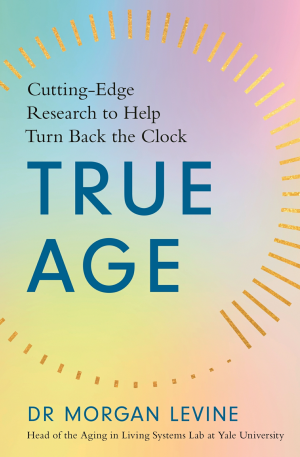
True Age: Cutting-Edge Research to Help Turn Back the Clock by Morgan Levine
Biological age—not chronological age—is what underlies the changes we see in the mirror. The changes we feel as we rise out of bed each morning. The changes that cause most of the diseases and conditions that plague living creatures as they grow old. We have been conditioned to care about our chronological age. To hide it or feel ashamed of it. But the opposite should be true. Our chronological age is a badge of honor. It represents our accomplishments, memories, and the moments spent with loved ones. It captures all the beautiful things that make life worth living. But the best, and perhaps only, way to truly earn more chronological years is by taking up arms against its unfortunate companion—biological age. Luckily, both nature and science have shown us that this is possible to a degree, and that in many ways, you hold the key.
Assuming we can use real-time biological data to accurately assess the extent of aging in a person, tissue, or even a cell, one could test the impact of interventions and behaviors at any point, ultimately compressing the time needed to run a clinical trial from decades to years or even months.
Armed with the insights biological age measures can provide, what’s a person to do? How do you determine whether calorie restriction (CR), a plant-based diet, intermittent fasting, cyclical keto, or some combination is right for you? One option—start testing! While not technically a well-controlled study, tracking your own biological age can help you biohack your own aging process. In addition to providing positive feedback, biological age tracking can also tell us when things are not working. Or perhaps more important, what things are not worth the time or investment (monetary or otherwise).
When it comes to optimizing health and aging, betterment doesn’t have to come via a pill bottle or through the needle’s tip at the end of a syringe. While we wait for those groundbreaking discoveries, there are things each of us can do for ourselves. By understanding and tracking our own aging process, we can discover ways to delay our own aging, discover habits that work for us, determine whether to seek medical advice before we are ever sick, and be accountable for our own health and wellness as we enjoy our chronological time on Earth.

The Longevity Leap: A Guide to Slowing Down Biological Aging and Adding Healthy Years to Your Life by Siim Land
The Longevity Leap comprises of two main components: delaying chronic diseases by trying to keep your health and biomarkers in the lowest risk category for as long as possible, and slowing down biological aging by trying to maintain biological youth in terms of physical function, biomarkers, cognitive function, and sex hormones. The two overlap to a certain extent, but by extending your disease-free life expectancy, you can effectively extend your longevity. How do you achieve that? By maintaining a youthful phenotype reflected by physical function, cognition, bloodwork, and other relevant biomarkers. Nobody has perfect markers, but by keeping them within the optimal range for as long as possible, especially the clinically most relevant ones, you’re effectively slowing down the development of chronic diseases and aging. The problem is that all the biomarkers and physical functions get worse with age, making it an uphill battle. However, by staying ahead of the curve you’ll have a much better time than the general population.
Tracking biomarkers from a strategic perspective is one of the best things for your longevity. Of course, the mere act of taking a blood test achieves nothing. You must act on your results and try to improve them. However, if you don’t even know what your biomarkers are, it’s very hard to know what needs to be changed. That’s why taking the tests is the first step in increasing your longevity intelligence. By knowing what’s not optimal, you’re going to be able to modify your lifestyle, your exercise routine, your diet, and supplements to improve your bloodwork.
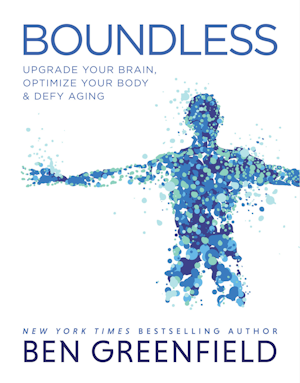
Boundless: Upgrade Your Brain, Optimize Your Body & Defy Aging by Ben Greenfield
Owning a boundless mind means you have balanced and complete levels of important neurotransmitters so that your nervous system can flawlessly communicate; your brain is free of inflammation and fog; you’ve developed potent stress-banishing and cortisol-decreasing strategies; your IQ is elevated, along with your working memory and executive function; you understand how to effectively use nootropics, smart drugs, and brain-enhancing foods, biohacks, gear, and tools; your sleep is pure, uninterrupted, and efficient; and, ultimately, you feel as though you actually have power and control over your thoughts, feelings, interactions, and communication.
Owning a boundless body means you know how to rapidly get lean and burn fat; you know how to build muscle in the safest, cleanest, and fastest way possible; you’ve fixed your gut, eliminated digestive issues, and maximized nutrient absorption; you know the ideal movements, exercises, tools, foods, supplements, and workouts for strength, power, speed, balance, mobility, and endurance; you’ve cracked the code on maximizing recovery and recovery speed; you possess an unstoppable immune system; and you have a potent arsenal of tools to increase your symmetry and beauty.
Owning a boundless spirit means that you can consciously control your thoughts and beliefs to positively affect your health; you have a thriving practice of gratitude, love, and joy; you understand how to use currently fringe methods such as sound healing and vibrational frequencies to enhance your physiology; you’ve optimized your social connections, friendships, and relationships; you’ve maximized tantra, love, and sexual satisfaction; you’ve optimized the hidden variables that can make or break your mind, body, and spirit, including air, light, electricity, and water; you’ve learned from residents of the world’s Blue Zones and longevity hot spots how to optimize your life, happiness, and fulfillment; and your daily habits and routines have allowed you to create your perfect day.
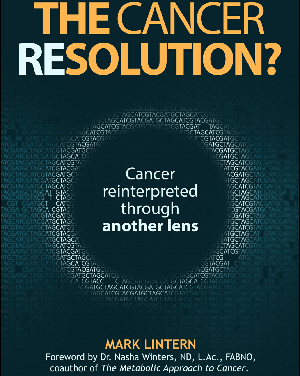
The Cancer Resolution? by Mark Lintern
For the last 60 years, cancer has been said to arise when the DNA contained within the cell nucleus – which holds the genetic instructions for our development, functioning, growth and reproduction – becomes damaged or mutated. These mutations allegedly drive abnormal cell growth, resulting in a tumour. This is important to know because the latest data indicates that this established view of cancer is incorrect. This raises some serious questions: what does this mean for mainstream cancer treatments? Are there more accurate explanations of the disease? And could this mean there are more effective ways to treat cancer? This book addresses these critical questions and offers something unique to the cancer conversation: the proposition of viewing cancer through a different lens with suggestions for a more coherent interpretation of the mechanisms that give rise to, and drive this elusive disease. Simply put, the new perspective of cancer presented herein, has the potential to greatly improve the survival outcome for all cancer patients.
It would seem there is an additional factor that has been overlooked, and a more straightforward explanation. While toxin exposure, nutrient deficiency, and immune weakness create the environment in which tumours can form, tumours cannot develop without the additional influence of a pathogenic micro-organism. A tumour arises due to a failure of damaged cells to eliminate opportunistic pathogens that take advantage of damaged tissue. Cancer, therefore, is a terrain-based disease that is immune system related, suppressive, domineering, and opportunistic in nature, and fungal in origin.
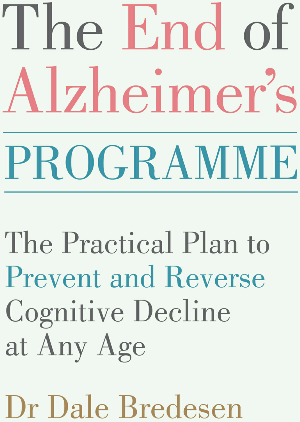
The End of Alzheimer's Programme: The Practical Plan to Prevent and Reverse Cognitive Decline at Any Age by Dale Bredesen
Cognitive decline often sneaks up on you. Indeed, the Nobel laureate Richard Feynman—the Einstein of the latter half of the twentieth century—developed cognitive decline, which turned out to be due to a subdural haematoma (a blood clot pushing against his brain). When the haematoma was removed and his brilliance had returned, he commented on the lack of insight one has into one’s own cognitive compromise. Thus these complex chronic illnesses are like a boa constrictor: as they take hold of you, for years you do not feel the squeeze … they wrap their coils around you, and you might feel a senior moment or two, or perhaps forget where you parked, but you think, Doesn’t everyone do that? Even the doctor cannot see the creeping constriction. Until it is too late and you have an advanced-stage terminal illness. Here’s the great news, though—the Achilles’ heel of all of these complex chronic illnesses is that we can see them coming for years ahead of time, thus giving us plenty of time for prevention (okay, so boa constrictors don’t have heels, I get it, but you see the point—we can conquer these diseases early on). All we have to do is bother to look.
The three components of the KetoFLEX 12/3 lifestyle are diet, fasting, and exercise (on a foundation of quality sleep). When these are combined, they heal metabolism and provide clean sustainable fuel for your brain. Practising these three strategies concurrently yields a synergistic effect that promotes more rapid healing than employing any one of them alone.
KetoFLEX 12/3 specifically focuses on the mechanisms known to contribute to cognitive decline. This lifestyle will: ■ Create critical insulin sensitivity ■ Reduce inflammation ■ Address neuronal fuel reduction and mitochondrial deficiency ■ Increase circulation and optimize blood pressure ■ Provide raw materials for synaptic support ■ Protect against nutrient deficiencies associated with cognitive decline ■ Promote cellular autophagy and beta-amyloid clearance ■ Promote detoxification ■ Protect against muscle and bone loss associated with cognitive decline. What makes the KetoFLEX 12/3 approach unique is that we encourage you to use actual data to help you optimize your health to achieve improved (and sustained) cognition. You needn’t wonder if you’re on the right track. You can track and tweak the effect your choices are having based on real-time data, periodic assessments, and laboratory testing.
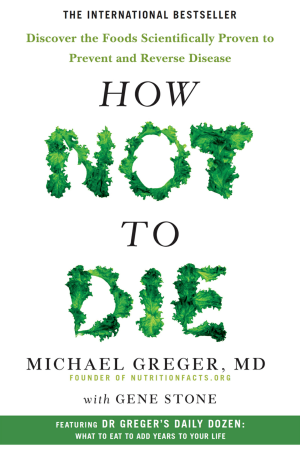
How Not to Die: Discover the Foods Scientifically Proven to Prevent and Reverse Disease by Michael Greger and Gene Stone
Last year alone, there were more than twenty-four thousand papers published in the medical literature on nutrition. This book is a long-awaited opportunity to share practical advice about how to put this life-changing, life-saving science into practice in our daily lives.
The book is divided into two parts: the “why” and the “how.” In part 1—the “why” to eat healthfully section—the author explores the role diet can play in the prevention, treatment, and reversal of the fifteen leading causes of death in the United States. Then takes a closer look at more practical aspects of healthy eating in the “how” to eat healthfully section presented in part 2. For example, we’ll see in part 1 why beans and greens are among the healthiest foods on earth. Then, in part 2, we’ll take a look at how best to eat them—we’ll explore such issues as how many greens to eat every day and whether they’re best cooked, tinned, fresh, or frozen. We’ll see in part 1 why it’s important to eat at least nine servings of fruits and vegetables daily, and then part 2 will help you decide whether to buy organic or conventional produce. Finally, the book offers real-world tips for grocery shopping and meal planning to make it as easy as possible to best feed yourself and your family.
Healthy foods are not necessary interchangeable. Some foods and food groups have special nutrients not found in abundance elsewhere. The list of foods recommended to fit into a daily diet includes: beans, berries, other fruits, cruciferous vegetables, greens, other vegetables, flaxseeds, nuts, spices and whole grains plus sources of vitamin B12, vitamin D, iodine and long-chain Omega-3s.
Additional reading: Becoming Vegan: Comprehensive Edition (The Complete Reference to Plant-Base Nutrition) by Brenda Davis and Vesanto Melina provides in-depth details on every required nutrient, includes specifics for various stages of life.
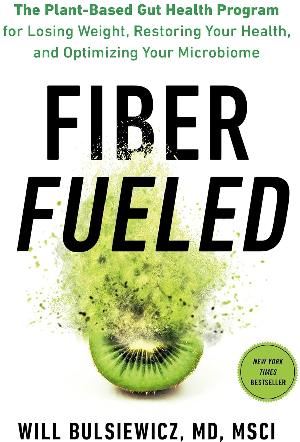
Fiber Fueled: The Plant-Based Gut Health Program for Losing Weight, Restoring Your Health, and Optimizing Your Microbiome by Will Bulsiewicz
Every single bite, all three pounds of food per day, flows downstream to your gut microbes. They are not passive observers. Our food is also their food. Yes, even invisible unicellular organisms need an energy source to fuel them. But not every microbe eats the same food. Each dietary choice you make will empower a specific group of microbes, while others will languish. If you permanently remove a food group, the microbes that thrive on that food will starve into extinction.
You control what it is you bite into, and therefore you control the makeup of your microbiome. The end result is a unique mix of microbes, as unique as a fingerprint. Those microbes go to work on your food and things don't end the way they started. Microbial metabolism leads to biochemical transformation of the food. In many cases, the healthy bacteria will reward us by molding our food into something that reduces inflammation and promotes health and balance. But the opposite can also be true. Unhealthy food feeds unhealthy microbes, and they punish us by creating compounds that inflame our body.
The single greatest predictor of a healthy gut microbiome is the diversity of plants in one's diet. The consumption of thirty different plants in a given week is the greatest predictor of gut microbial diversity. The diversity within our microbiome would be proportional to the diversity of plants in our diet. More plant-based diversity = stronger, healthier microbiota = stronger, healthier you.
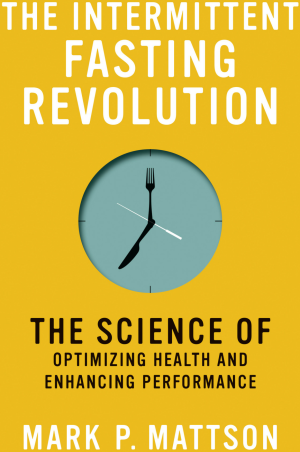
The Intermittent Fasting Revolution: The Science of Optimizing Health and Enhancing Performance by Mark P. Mattson
Intermittent fasting is not a diet. A diet is what is eaten and how much is eaten. In contrast, intermittent fasting is an eating pattern that includes frequent periods of time with little or negligible amounts of food of sufficient duration to cause “fat burning.” You are in a fasted state when all of the energy (glucose) stored in your liver has been depleted and fats released from your fat cells are then converted to ketones. In humans, the liver contains enough glucose to last no more than 12 hours, and ketone levels in the blood then begin to rise. Ketones are used as a fuel for nerve and muscle cells during fasting, and they also stimulate these cells in ways that enable them to resist stress and combat disease. Three of the most popular intermittent fasting eating patterns are daily fasts of 16 to 20 hours, which is often referred to as “daily time-restricted eating”; fasting two days every week, which has been dubbed “5:2 intermittent fasting”; and fasting five days in a row every month.
Intermittent fasting slows aging, reduces inflammation, improves glucose regulation, lowers blood pressure, facilitates fat loss, and may reduce the risk of diabetes, heart disease, and cancers.
Additional reading: The Longevity Diet by Valter Longo demonstrates benefits of periodic 5 days fasting-mimicking diet low in proteins and sugars and rich in healthy fats.
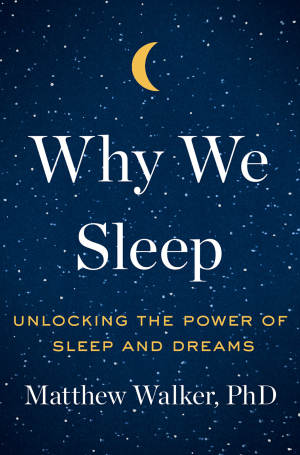
Why We Sleep: Unlocking the Power of Sleep and Dreams by Matthew Walker
We sleep for a rich litany of functions, plural—an abundant constellation of nighttime benefits that service both our brains and our bodies. Within the brain, sleep enriches a diversity of functions, including our ability to learn, memorize, and make logical decisions and choices. Benevolently servicing our psychological health, sleep recalibrates our emotional brain circuits, allowing us to navigate next-day social and psychological challenges with cool-headed composure. Downstairs in the body, sleep restocks the armory of our immune system, helping fight malignancy, preventing infection, and warding off all manner of sickness. Sleep reforms the body’s metabolic state by fine-tuning the balance of insulin and circulating glucose. Sleep further regulates our appetite, helping control body weight through healthy food selection rather than rash impulsivity. Plentiful sleep maintains a flourishing microbiome within your gut from which we know so much of our nutritional health begins. Adequate sleep is intimately tied to the fitness of our cardiovascular system, lowering blood pressure while keeping our hearts in fine condition.
A balanced diet and exercise are of vital importance, yes. But we now see sleep as the preeminent force in this health trinity. The physical and mental impairments caused by one night of bad sleep dwarf those caused by an equivalent absence of food or exercise. It is difficult to imagine any other state—natural or medically manipulated—that affords a more powerful redressing of physical and mental health at every level of analysis.
Sleep is the single most effective thing we can do to reset our brain and body health each day—Mother Nature’s best effort yet at contra-death. Unfortunately, the real evidence that makes clear all of the dangers that befall individuals and societies when sleep becomes short have not been clearly telegraphed to the public. It is the most glaring omission in the contemporary health conversation. In response, this book is intended to serve as a scientifically accurate intervention addressing this unmet need. It aims to revise our cultural appreciation of sleep, and reverse our neglect of it.
Additional reading: The Sleep Solution (Why Your Sleep is Broken and How to Fix It) by W. Chris Winter provides practical recommendations to help anyone achieve healthy sleep.

The One-Minute Workout: Science Shows a Way to Get Fit That's Smarter, Faster by Martin Gibala and Christopher Shulgan
Most of us are under the impression that exercise has to be time-intensive. We have this notion that it takes at least an hour to get in a good workout.
The past decade has seen an explosion of research into the science of high-intensity interval training, better known by its acronym, HIIT, pronounced “hit.” We’re learning that HIIT can provide serious benefits that increase a workout’s time-efficiency. Sprint interval training, or SIT, which is the most extreme version of the technique and is characterized by a few brief bursts of all-out exercise, is especially potent.
A method exists that enables you to reap the benefits of hours of exercise in just minutes per day. Strategies can be incorporated to transform you from out of shape to fit in the least amount of time possible. Among author's biggest discoveries is a workout that provides the benefits of nearly an hour of steady aerobic exercise with just a single minute of hard exercising.
The harder and faster you go, the less time your exercise requires. Go as hard as you can in short bursts, and you can get the benefits of an endurance exercise regimen with less than 5 percent of the time spent in hard exercise, 10 percent of the work expended, and only one-third of the total workout time commitment.
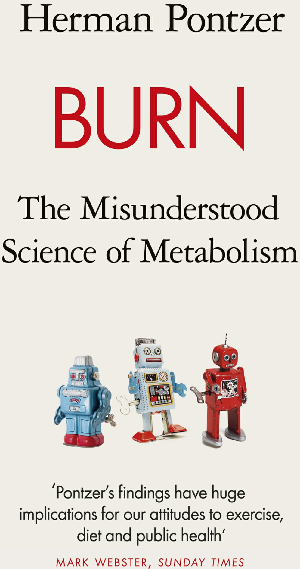
Burn: The Misunderstood Science of Metabolism by Herman Pontzer
Why do humans burn around 2,500 to 3,000 kcal per day? Why do some of us burn more energy each day than expected for our size, while others burn less? How does our metabolism affect our health and longevity? And how does our lifestyle, our daily routines of physical activity and diet, affect our energy expenditure and metabolic health?
The realization that daily energy expenditure is constrained changes the way we think about the modern obesity epidemic. First, the fact that hunter-gatherers burn the same amount of energy as urbanites in the developed world means that daily energy expenditure is likely unchanged from our Paleolithic past to the computerized present. The modern explosion in obesity and all its downstream effects can’t be blamed on decreasing energy expenditures in industrialized countries. Doubly labeled water studies in the industrialized world, which stretch back to the 1980s, seem to confirm this: daily energy expenditures and the PAL ratio have stayed the same in the United States and Europe for the past four decades, even as obesity and metabolic disease have skyrocketed.
Second, constrained daily energy expenditure means that increasing daily activity through exercise or other programs will ultimately have little effect on the calories burned per day. This realization should change the way we tackle obesity. Weight change is fundamentally about energy balance: if we eat more calories than we burn, we gain weight; if we burn more than we eat, we lose weight. Those are the rules of physics and, as established by Lavoisier, Atwater, Rubner, and the pioneers of metabolic science, humans and other animals play by the rules. The widespread evidence that daily energy expenditure is constrained tells us that durable, meaningful changes in daily energy expenditure are extremely difficult to achieve through exercise. If the energy burned is really difficult to budge no matter how much we exercise, we’d be better off battling obesity by focusing on the amount of energy we eat.
Exercise is still essential for health! You still need to exercise! As we’ll see, the constraint on daily energy expenditure is actually an important reason why exercise is so good for you. Exercise will keep you healthy and alive. It just won’t do much for your weight.
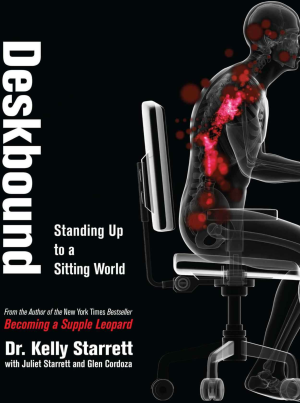
Deskbound: Standing Up to a Sitting World by Kelly Starrett, Juliet Starrett and Glen Cordoza
Sitting for as little as two continuous hours increases the risk of heart disease, diabetes, metabolic syndrome, cancer, back and neck pain, and other orthopedic problems. Sitting will shorten your life, just like smoking.
Many studies are also demonstrating that the effects of long-term sitting aren’t reversible through exercise or other good habits. This means that if you eat well and work out religiously for an hour a day, but then sit for all or most of your other waking hours, the sitting behavior will chip away or even cancel out the benefits of all your exercise at the gym. You are still considered a sedentary person.
How do we make sense of this—and fix it? The answer is simple. Unless we are asleep, we human beings are designed to move. Our normal physiology depends on this important fact. We evolved a central nervous system to sense changes around us and to move us through our environment. For nearly 200,000 years, Homo sapiens spent the majority of their time on the move. If they wanted something to eat, they had to hunt for it or dig it up out of the ground. If they wanted to travel, they had to get there by foot. All the movement that surrounded survival might sound exhausting to us now, but that activity shaped our bodies’ design, both internally and externally. Our bodies are built for movement, and in turn movement keeps our bodies healthy. It is a symbiotic relationship that has allowed our species to survive.
To help encourage movement, many forward-thinking companies are starting to offer their employees standing workstations. This is wonderful because standing not only burns more calories than sitting, but also promotes more movement throughout the day. When you stand, you can shift from side to side, alternate between standing on both feet and leaning against a stool, and walk away from your computer for a moment. It’s also far easier to take short movement breaks, which add up to a lot of movement over the course of a day.
Additional reading: Becoming a Supple Leopard (The Ultimate Guide to Resolving Pain, Preventing Injury, and Optimizing Athletic Performance) by Kelly Starrett and Glen Cordoza will teach you how to move correctly in all situations.

Overcoming Gravity: A Systematic Approach to Gymnastics and Bodyweight Strength (Second Edition) by Steven Low
Mastering your body requires a lot of hard work and persistence, but the potential for overall results is astounding. Bodyweight exercises can be performed almost anywhere with minimal equipment, are fun to play around with, and it doesn’t hurt that they can be visually impressive. Strength levels acquired from proper bodyweight training transfers over to all other forms of strength, including weight training. Bodyweight strength training is thus extremely rewarding.
The primary goal of this book is to allow beginner and intermediate athletes to delve into the world of bodyweight strength training and progress effectively and safely. This book will equip you with the knowledge to build safe and effective workouts and progress in your bodyweight strength movements. Additionally, there will be condensed exploration on subjects that relate to general movement such as endurance, metabolic conditioning, cardio, nutrition, and the like, to add support and stability to the programming and subsequent training.

The Mind Illuminated: A Complete Meditation Guide Integrating Buddhist Wisdom and Brain Science for Greater Mindfulness by John Yates, Matthew Immergut and Jeremy Graves
Meditation is a science, the systematic process of training the mind. It is the science of meditation that allows people from all walks of life to experience the same amazing benefits. A regular sitting practice has been shown to enhance concentration, lower blood pressure, and improve sleep. It is used to treat chronic pain, post-traumatic stress, anxiety, depression, and obsessive-compulsive disorders. Meditators develop valuable insights into their personality, behaviors, and relationships, making it easier to recognize and change past conditioning and counterproductive views that make life difficult. They have a greater awareness and sensitivity to others, which is enormously helpful at work and in personal relationships. The calming and relaxing effects of meditation also translate into increased emotional stability when confronting the inevitable stresses of life.
The purpose of this book is to create a detailed and comprehensive meditation manual that is easy to use. Much has been written about the many benefits of meditation and its contributions to emotional, psychological, and social well-being. But there is surprisingly little information available on how the mind works and how to train it. This is an attempt to fill that conspicuous need. This book is appropriate for anyone with a strong interest in meditation, from a complete beginner to someone who has practiced for decades. It will be particularly useful for those who already have a practice and feel ready to go further on the contemplative path. It’s also for people who are dissatisfied with their progress despite years of meditation. This includes practitioners who feel they’ve actually benefited from meditation, but who have started to believe the more profound states of consciousness meditation offers are beyond their reach. Rest assured, the full rewards of meditation are closer than you think.

Feeling Good: The New Mood Therapy by David Burns
The powerful principle at the heart of cognitive therapy— your feelings result from the messages you give yourself. In fact, your thoughts often have much more to do with how you feel than what is actually happening in your life.
It is an obvious neurological fact that before you can experience any event, you must process it with your mind and give it meaning. You must understand what is happening to you before you can feel it. If your understanding of what is happening is accurate, your emotions will be normal. If your perception is twisted and distorted in some way, your emotional response will be abnormal.
The author teaches how to avoid painful feelings based on mental distortions, because they are neither valid nor desirable. Once you have learned how to perceive life more realistically you will experience an enhanced emotional life with a greater appreciation for genuine sadness— which lacks distortion— as well as joy. You can learn to correct the distortions that fool you when you are upset. At the same time, you will have the opportunity to reevaluate some of the basic values and assumptions that create your vulnerability to destructive mood swings. The modifications in illogical thinking patterns will have a profound effect on your moods and increase your capacity for productive living.
Additional reading: Feeling Great (The Revolutionary New Treatment for Depression and Anxiety) by David Burns gives new techniques to break out of feelings of self-doubt and despair.
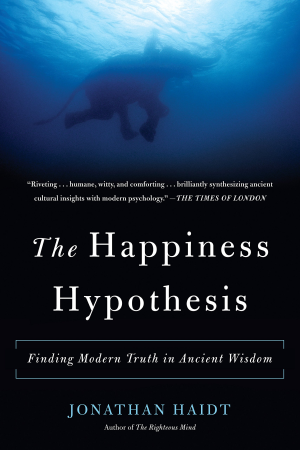
The Happiness Hypothesis: Finding Modern Truth in Ancient Wisdom by Jonathan Haidt
What can you do to have a good, happy, fulfilling, and meaningful life? What is the answer to the question of purpose within life? The author believes the answer can be found only by understanding the kind of creature that we are, divided in the many ways we are divided. We were shaped by individual selection to be selfish creatures who struggle for resources, pleasure, and prestige, and we were shaped by group selection to be hive creatures who long to lose ourselves in something larger. We are social creatures who need love and attachments, and we are industrious creatures with needs for effectance, able to enter a state of vital engagement with our work. We are the rider and we are the elephant, and our mental health depends on the two working together, each drawing on the others’ strengths.
The final version of the happiness hypothesis is that happiness comes from between. Happiness is not something that you can find, acquire, or achieve directly. You have to get the conditions right and then wait. Some of those conditions are within you, such as coherence among the parts and levels of your personality. Other conditions require relationships to things beyond you: Just as plants need sun, water, and good soil to thrive, people need love, work, and a connection to something larger. It is worth striving to get the right relationships between yourself and others, between yourself and your work, and between yourself and something larger than yourself. If you get these relationships right, a sense of purpose and meaning will emerge.
This is a book about ten Great Ideas. Each chapter is an attempt to savor one idea that has been discovered by several of the world’s civilizations—to question it in light of what we now know from scientific research, and to extract from it the lessons that still apply to our modern lives.